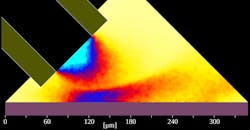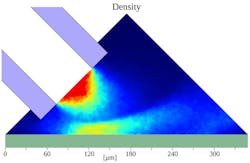Supersonic Gas Speeds Nanoscale 3D Printing
Engineers at the Georgia Institute of Technology have devised a method of energizing precursor molecules used in 3D printing nanoscale parts by using a tiny, high-energy supersonic jet of inert gas. This dramatically accelerates fabrication of nanometer scale structures. The 3D printing technique also lets them make structures with high aspect ratios. Now, a theory they developed to describe the technique could lead to new applications for 3D printing nanoscale parts and new nanoscale materials.
Based on focused electron beam deposition, the technique lets structures to be made out of gas-phase precursors at rates approaching what could be expected in the liquid phase, all without raising the temperature of substrates. That could lead to manufacturing of nanometer-scale structures at rates that could make them practical for use in magnetic memories, high-frequency antennas, quantum communication devices, spintronics, and atomic-scale resonators.
The work grew out of frustration with trying to create small structures using electron beams, which can be just a few nanometers in diameter. “When we went to the lab to use nanofabrication with focused electron beams, which are the size of a few nanometers, we could not grow structures that were just a few nanometers. They grew to be 50 or 100 nanometers,” says Andrei Fedorov, a mechanical engineer at Georgia Tech. “And it also took a long time to print the structures, which meant that, without improvements, we’d never be able to mass-produce them.”
This cross-section view shows molecular density of the supersonic gas jet as it expands in vacuum and impinges onto a substrate, leading to accelerated material deposition from an energized adsorbed precursor. (Credit: Matthew R. Henry)
The research team realized the reactions producing the structures were slow, and this lack of speed was tied to the thermodynamic state of the substrate on which they are being grown. They decided to add some energy to the process to speed things.
The result was the invention of a micro-capillary injector just a few micrometers in diameter that could introduce tiny jets of gaseous molecules into the deposition chamber to activate precursors for nanometer-scale structures. Partly because the jet is entering a vacuum chamber, the gas accelerates to supersonic speeds. Energy from the supersonic jet excites the precursor molecules adsorbed into the substrate.
“This energetic thermal state lets electrons from the beam to more easily break chemical bonds, and as a result, structures grow much faster,” Fedorov explains. “All of this acceleration, both the molecule transport and the rate of reaction, are exponential, meaning a small change can lead to a dramatic increase in outcome.”
That much has been observed experimentally, but to understand how to control the process and expand its applications, the researchers wanted to create a theory for what they were seeing. They used nano-scale thermometric techniques to measure the temperature of the adsorbed atoms (also known as adatoms) subjected to the jet and used that information to help understand the basic physics at work.
Development of the model and understanding of the first-principles physics behind it will let other researchers find new applications.
“With this, you can have almost the same order of magnitude growth rate as you’d have with liquid phase precursors, but still have access to the richness of possible precursors, the ability to manipulate alloying, and all the experience that has been developed over the years with gas phase deposition,” Fedorov says. “This technology will let us do things at a scale that is meaningful from a practical standpoint and cost-effective.”
This colorized scanning electron microscope image shows the position of a resistive thermal device (nanoscale thermometer) as the deposition substrate moves relative to the micro-size nozzle capillary for gas jet injection for mapping local temperature. The RTD thermal response was used for validation of the model prediction of the adatom non-equilibrium thermal state. (Credit: Matthew R. Henry)
For example, the ability to rapidly build small structures will open up a range of new applications. “If you can adapt 3D printing techniques, this could bring a lot of new capabilities for magnetic memory, superconducting materials, quantum devices, 3D electronic circuitry, and many more things,” he said. “These structures are currently very hard to make using conventional methods.”
Beyond using the jets to accelerate deposition of precursor materials already on the substrate, the researchers have also created hybrid jets that contain both high-energy inert gas and precursor gases, which accelerate nanostructure growth and precisely control material composition during growth. In future work, the researchers plan to use these hybrid approaches to form nanostructures with phase and topology that cannot be achieved by any other nanofabrication techniques.



